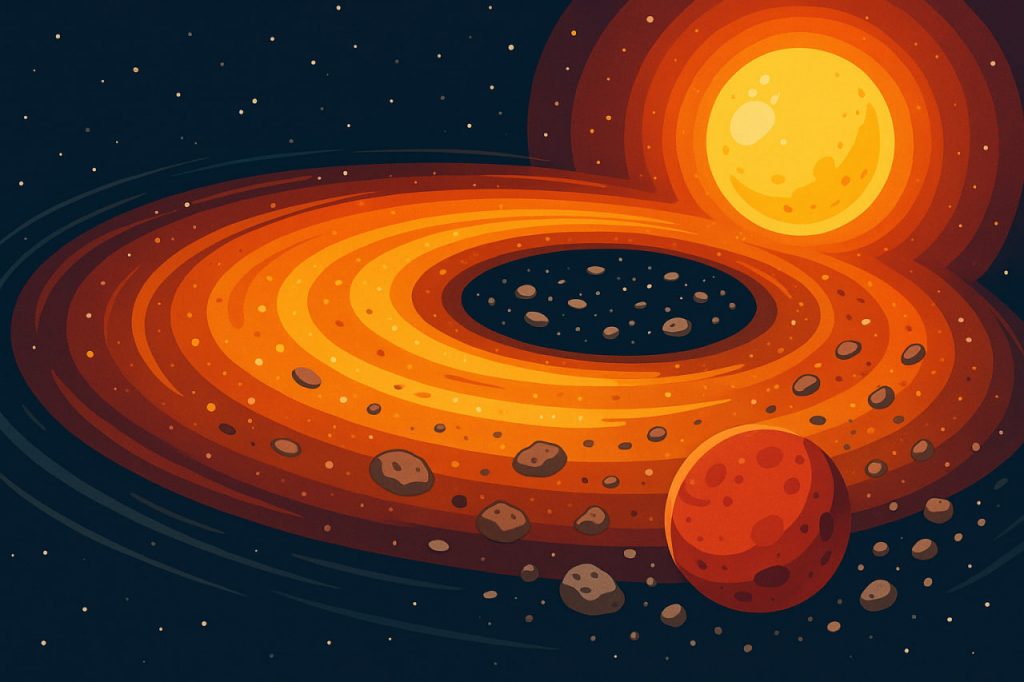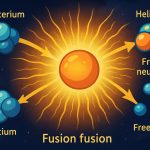Planets don’t simply appear — they are the result of complex processes unfolding over millions of years. From dust particles in a swirling cloud of gas to massive, orbiting worlds, planetary formation is a fundamental chapter in the evolution of solar systems. Understanding how planets form not only explains Earth’s origin but also helps scientists search for exoplanets and assess their potential to support life.
Step 1: Formation of a Protoplanetary Disk
Planetary formation begins with a nebula — a giant cloud of gas and dust left over from earlier generations of stars. Gravity pulls the material inward, and as the cloud collapses, it begins to spin and flatten into a protoplanetary disk around a newborn star.
In the center, the material becomes hot and dense, forming a protostar. Meanwhile, in the cooler outer regions of the disk, dust grains begin to stick together, marking the first stage of planet building.
Step 2: Dust to Pebbles to Planetesimals
Tiny particles in the disk collide and merge due to electrostatic forces. Over time, they grow into pebbles, then rocks, and eventually form planetesimals — objects at least a kilometer wide. These planetesimals have enough gravity to pull in surrounding material, growing rapidly in size.
This stage is often chaotic. Collisions can be violent, and some bodies are shattered. However, the largest ones survive and continue accumulating mass through accretion.
Step 3: Formation of Protoplanets
As planetesimals merge, they form protoplanets — early versions of planets. Their gravity clears their orbit of smaller debris. The process is influenced by the distance from the star:
- In the inner disk, where it’s hotter, only metals and rocks can condense, forming rocky planets like Earth and Mars.
- In the outer disk, where it’s cooler, ices and gases can remain solid, allowing the formation of massive gas giants like Jupiter and Saturn.
This difference in temperature and material explains why the inner and outer planets are so different in composition.
Step 4: Gas Accretion and Differentiation
Once a protoplanet becomes large enough, especially in the outer disk, it can attract gas from the disk. This leads to the formation of gas giants with thick atmospheres.
Meanwhile, inside the protoplanets, heavier elements sink to the center, while lighter materials rise — a process called differentiation. This creates layered structures with cores, mantles, and crusts, as seen on Earth.
Eventually, the star ignites fully, creating stellar winds that blow away the remaining gas and halt further growth. The system stabilizes into a collection of planets, moons, asteroids, and comets.
Variations in Planet Formation
Not all planets follow the same path. In some systems:
- Giant planets may migrate, disrupting smaller bodies.
- Some stars form super-Earths — rocky planets larger than Earth but smaller than Neptune.
- Interactions with other stars may scatter planets or eject them into space entirely (called rogue planets).
Studying these differences helps astronomers understand the diversity of planetary systems in the universe.
Why Planet Formation Matters
Understanding how planets form helps answer fundamental questions:
- How common are Earth-like planets?
- Can planets form in binary star systems?
- What conditions are needed for life to arise?
Missions like ALMA, JWST, and Gaia provide real-time data on protoplanetary disks and young exoplanet systems, allowing us to witness planet formation in distant parts of the galaxy.
Glossary
- Nebula: A cloud of gas and dust where stars and planets can form.
- Protoplanetary disk: A rotating disk of material around a young star, where planets begin to form.
- Planetesimal: A small body formed from dust and gas in a disk, considered a building block of planets.
- Accretion: Growth by gradually accumulating more material through gravity.
- Differentiation: The process by which a planet’s internal layers form.
- Gas giant: A large planet composed mostly of hydrogen and helium, like Jupiter or Saturn.
- Rogue planet: A planet that drifts through space without orbiting a star.


